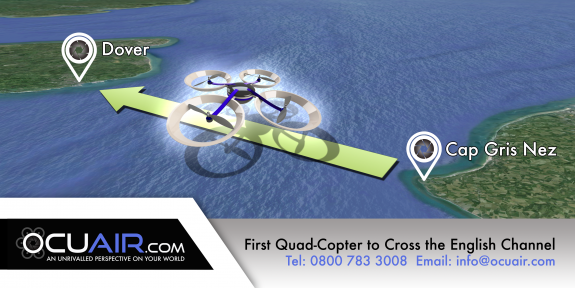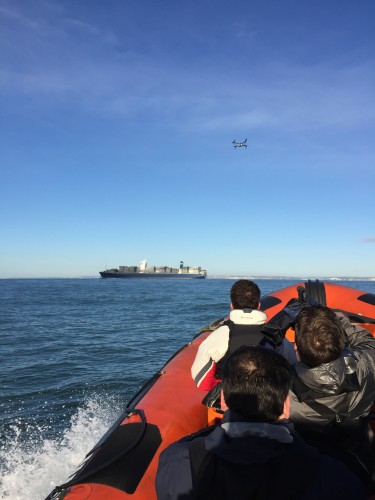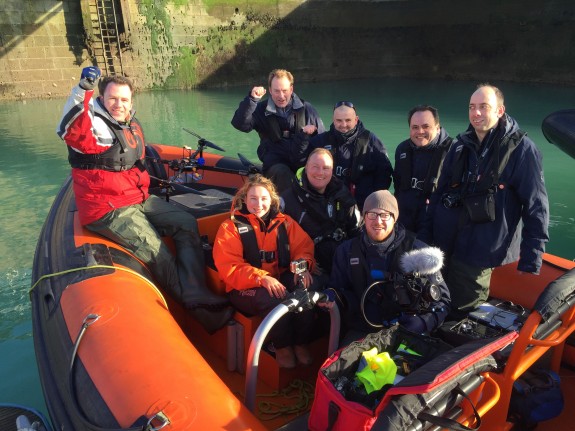The longest single flight of a quad-copter in the world was completed by a UK team of drone experts after they successfully completed their bid to be the first team in history to fly a drone across the English Channel in a single flight of 35km on Tuesday.
The team, lead by Richard Gill from Retford, Nottinghamshire, joined the ranks of Jean-Pierre Blanchard, John Jeffries, Louis Bleriot and Harriet Quimby after setting a famous aviation milestone.
Richard will be speaking at the RICS Matrics Leicestershire and Rutland ‘drones and the use’ seminar at 6:30-9:30pm on Thursday February 25 at Chutney Ivy.
The presenters, Ocuair Ltd, will be delivering a comprehensive educational session on the current legislation and capabilities of the commercially available drones in the UK.
The sessions will focus on the history of the technology in the commercial sector and the U.K. legislative environment and licensing requirements for drones.
Amidst their accomplishments the team established a number of world firsts in a commercially relevant context.

When asked about the records that he had set, Richard said: “It is hard to say how many records we have made and broken today but I can say that, to my knowledge, I am the first person to fly a quad-copter drone across the English Channel.”
The flight occurred on the morning of February 16 2016, Richard and his team travelled to the beach near Wissant in Northern France, and after facing some trouble whilst attempting to get the drone into the air, they finally began the 35km flight back to the UK.
Despite that the journey was scheduled to take around 80-90 minutes it wasn’t all smooth sailing.
The English Channel is the busiest shipping lane in the world and the drone and the boat had to dodge between two large vessels.
With margins as tight as these, Richard couldn’t afford to make any large scaled deviations from the most direct route.
The flight went well until the team passed the point of no return at the 17km mark, where it was a further distance back to their original launch position than it was to get to the UK, at 23km there was no escape plan when something strange happened.

The drone suddenly lurched to the left and Richard had to disable GPS assistance and manually fly the drone for a total of 20 minutes, an extremely challenging task.
The weather conditions were critical given that Richard was operating on the very edge of what is practically possible for a quad-copter, meaning that any type of adverse wind would have had a severe impact on the drone.
This would have meant that it might not have made the distance, and given that he was flying over water there were no second chances or emergency landings.
When he was questioned why he wanted to do it, Richard said: “I wanted to do something to stand out and show what this technology is capable of, companies like Amazon, with their Prime Air service, have seen the commercial potential of drones. This attempt pushes the boundaries of what is technically possible.
“Small, unmanned aerial vehicles are the next horizon in aviation so I wanted to see if I could do something to push the technology in a meaningful way. The UK leads the world in terms of legislation, I thought it would be good to see us lead the world in commercial UAV applications too.”
Drones have received a lot of bad press in previous years, but this success shows what can be achieved and how the technology can be used in a safe and responsible manner. The ability to fly across the channel has a certain pedigree within aviation history, a party which drones are now joining.
The drone that the team flew, the Enduro 1 drone, was made using the very latest cutting edge technology.
A custom airframe was designed by UK based UAV manufacturer Vulcan UAV. Efficient T-Motors and blades provided the lift, Optipower provided two huge 22 Amp hour batteries and Jeti provided the secure and robust control links. Nottingham Scientific Ltd also provided the GPS tracking devices.
The drone had full approval from both the UK Civil Aviation Authority (CAA) and French Direction générale de l’aviation civile (DGAC) for the crossing.
The team also operated within the standard rules for commercial UAV operations in the UK.
Speaking about the records that the team had set, Simon Vaitevicius, Officer of the British Model Flying Association Records, said: “This record is so important in the context of future drone activity such as delivering parcels because it proves that drones can be used over a distance, reliably over time.”

Tickets are priced at £16.66, to book a place at the event please visit :Drone Conference
By Emma Smith







